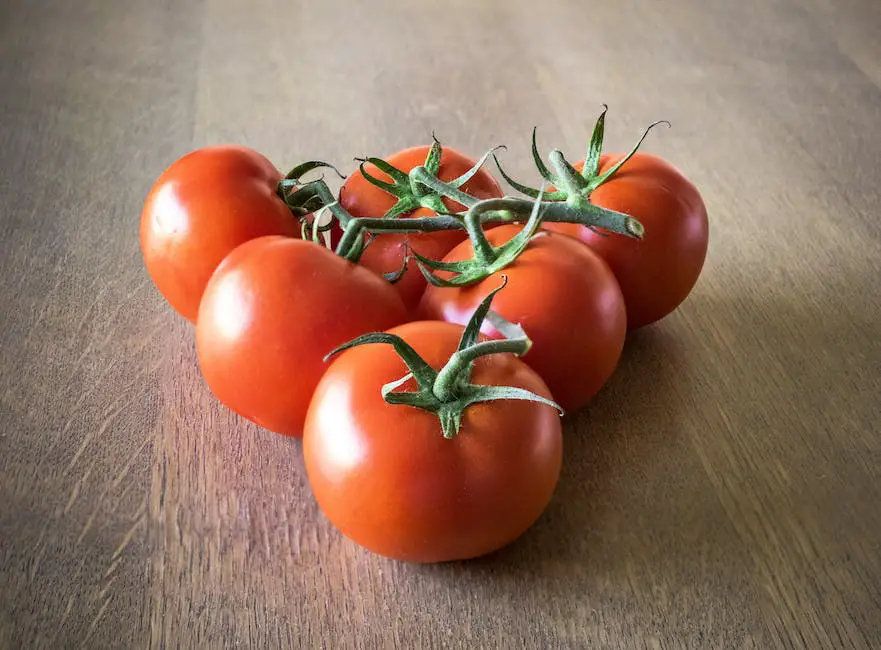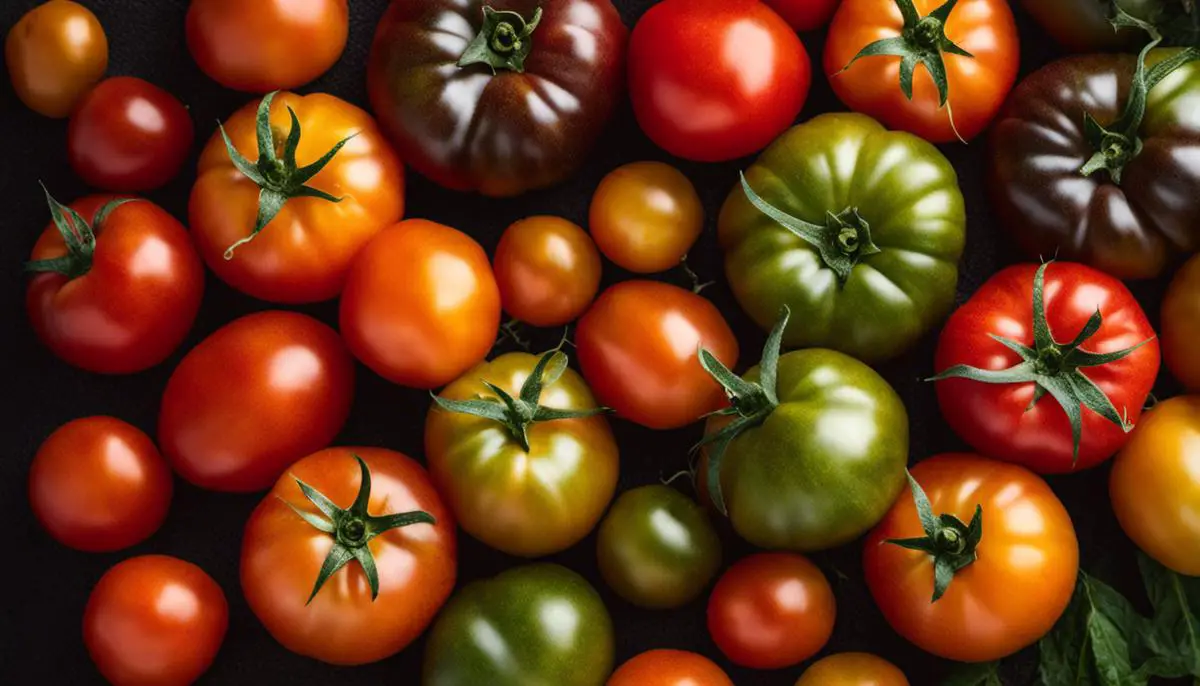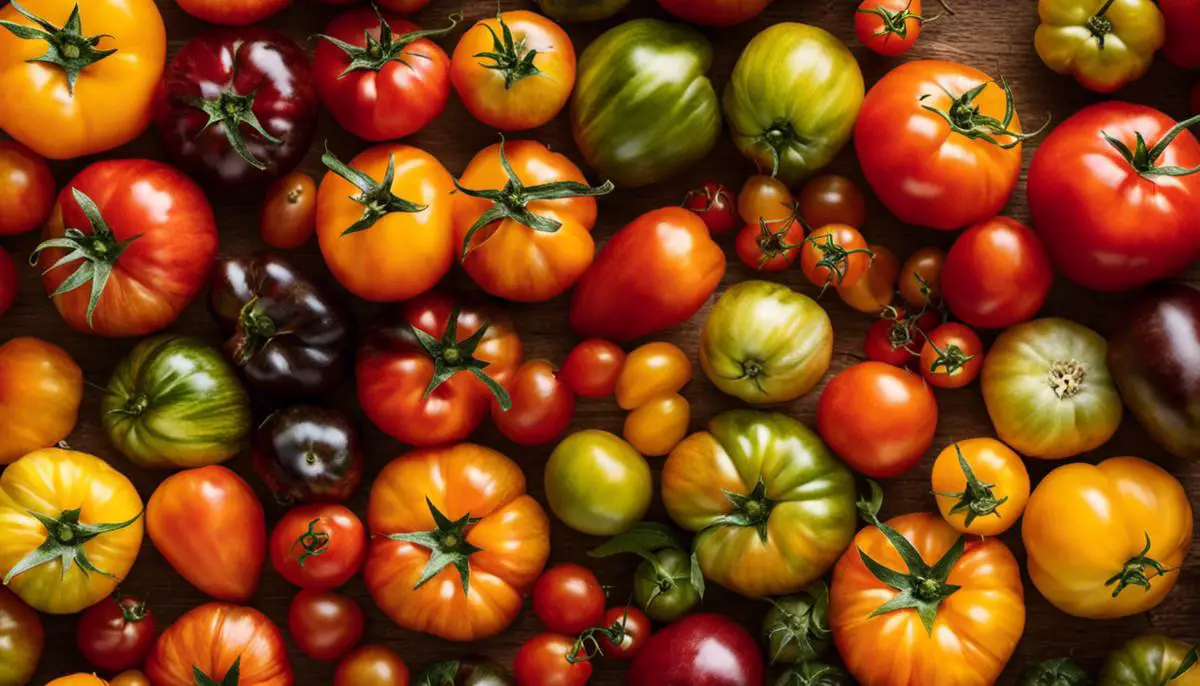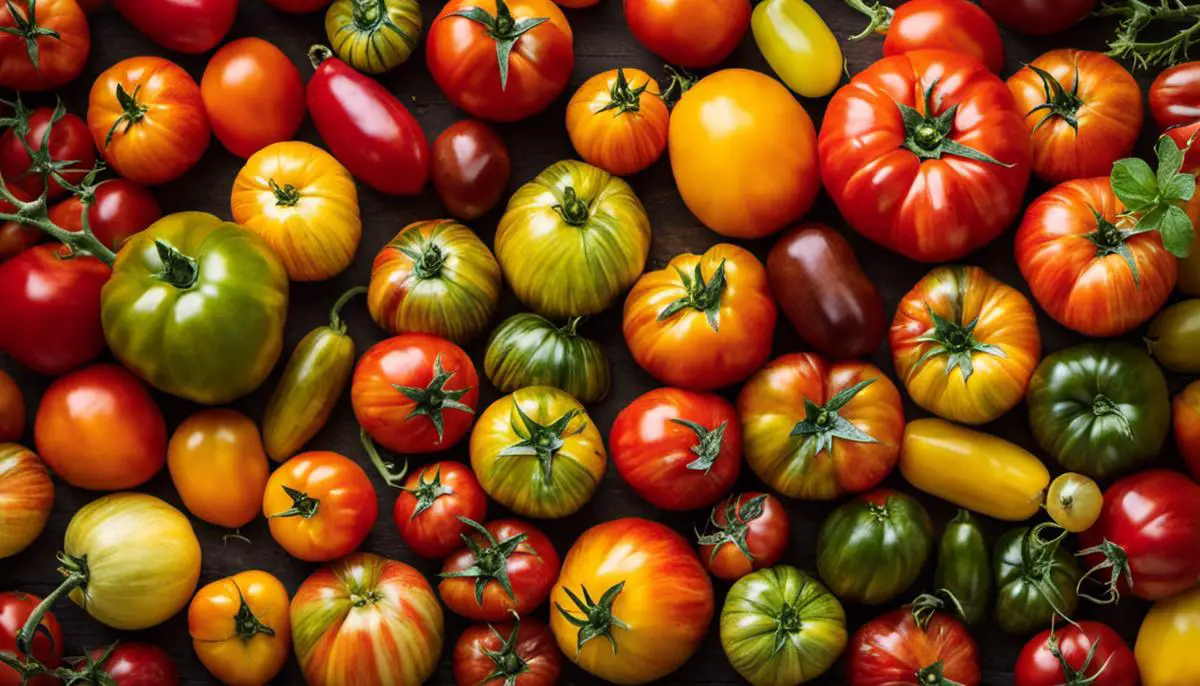Table of Contents
With their unique tastes, vivid colors, and varied shapes, heirloom tomatoes capture the very essence of summer and garden-to-table freshness. These old-fashioned, non-hybrid varieties of tomatoes bring an unmatched, true tomato flavor that speaks of the rich agricultural heritage they embody. This writing provides insight into the world of heirloom tomatoes- their definition, distinctive features, origination story, and how they differ from their hybrid counterparts. Furthermore, we dive into the agrarian aspects of cultivating these vintage fruits, reveal their impressive nutritional profile and health benefits, and explore the wealth of their culinary uses spanning from simple salads to gourmet dishes.
Understanding Heirloom Tomatoes
Heirloom Tomatoes
Heirloom tomatoes, fondly referred to as “heritage tomatoes” in the UK, are well-aged varieties whose seeds are passed down from generation to generation by well vigilant tomato growers to preserve the rich taste, color, and texture. Unlike hybrid tomatoes, which are genetically modified for mass production, heirloom tomatoes are traditionally pollinated, allowing them to retain their original traits over the years.
Distinguishing Heirloom Tomatoes
Distinguishing heirloom tomatoes from other varieties is primarily a matter of their rich lineage. True heirlooms are varieties that have been passed down for at least 50 years. They are often tied to a specific region or family, pointing towards a rich historical connection. In contrast, hybrids are bred for certain characteristics such as disease resistance, uniformity, shelf life, and year-round availability. Even though heirlooms may lack in these areas, they are renowned for their superior taste and unusual appearances.
The Origins of Heirloom Tomatoes
The origins of heirloom tomatoes trace back to Central and South America. The Aztec people in Mexico cultivated these tomatoes around 700 AD. Later on, explorers from Spain distributed tomatoes throughout their colonies in the Caribbean. The Spanish also brought them to Europe and the Philippines. From these later points, tomatoes further spread to other parts of Asia. The name “tomato” itself comes from the Nahuatl language (the language of the Aztecs), which called the fruit “xitomatl”.
Understanding Heirloom Tomatoes and their Exclusive Traits
Heirloom tomatoes are esteemed for their myriad unique attributes, evident in their mesmerizing hues, distinct shapes, variable sizes, and unparalleled flavors. A stark contrast to the conventional round, red tomatoes found in supermarkets, heirlooms deliver diversity in visuals with shades of yellow, purple, green, and even black. Along with color, they also showcase unique patterns like stripes or multicolor designs. Ranging from the size of small cherry tomatoes to ones weighing close to a pound, their wide variety is evident. Flavor-wise, these tomatoes possess a range of tastes, from sweet and tangy to smoky, setting them apart. Moreover, each heirloom tomato variety has its characteristic features and seasonality, ripening at different times throughout the year.

Cultivating Heirloom Tomatoes
A Closer Look at the Distinctiveness of Heirloom Tomatoes
Delving deeper into what makes them unique, heirloom tomatoes are a distinctive variety of tomatoes that have seen generations. Their valued traits have led to their cultivation and preservation over time. Unlike their hybrid counterparts, heirlooms are open-pollinated, signifying their pollination via natural methods such as insects or wind, without the need for human interference. Renowned for their robust, exceptional flavors, striking colors, and atypical shapes, heirlooms have carved a niche for themselves, achieving immense popularity among home gardeners and gourmet chefs.
Understanding the Ideal Growing Conditions
To cultivate heirloom tomatoes successfully, understanding the ideal growing conditions is paramount. These tomatoes thrive best in climates with warm temperatures, specifically between 70 and 90 degrees Fahrenheit, as tomatoes are sensitive to frost.
Perfecting the Soil
The soil composition is equally as important when growing heirloom tomatoes. They prefer well-drained, loamy soil with a slightly acidic pH. Amending your garden soil with organic matter, like compost or well-rotted manure, can help optimize the soil’s fertility and drainage, providing a conducive environment for the tomatoes to flourish.
Sunlight and Watering Needs
Heirloom tomatoes are sun-loving plants. A spot that receives at least 6-8 hours of direct sun ensures healthy growth. Their watering needs depend on the climate and the moisture-retaining capacity of your soil. However, a general rule is to keep the soil consistently moist but not waterlogged. Regular, deep watering is usually preferred over frequent light watering.
Pests and Diseases
Heirloom types of tomatoes have lesser resistance to diseases and pests when compared to hybrid types. It is crucial to routinely check on your plants for any signs of pest infestations or diseases like Tomato Blight or Blossom End Rot. Employ organic pest control methods and preventive measures like crop rotation and proper spacing between plants to reduce these risks.
Caring for Heirloom Tomatoes
Attention to detail goes a long way in cultivating heirloom tomatoes. Regularly remove the tomato suckers, the small sprouts that grow between the main stem and the branches, to direct more energy towards the growth of fruits. Additionally, using stakes or cages can support the growing plants and keep them off the ground, reducing the chances of disease transmission.
Understanding Heirloom Tomatoes
Heirloom tomatoes are a unique variety coursed through several generations due to their notable characteristics. Unlike commercially cultivated hybrid tomatoes, these heirlooms are open-pollinated. This implies that instead of human intervention for pollination, they rely on the natural means offered by the wind or insects.

Health and Nutritional Benefits of Heirloom Tomatoes
Harvesting Your Heirloom Tomatoes
Knowing when to harvest these precious tomatoes can be determined by observing their vibrant, full color and firmness. Bear in mind though, heirloom tomatoes are often more delicate compared to their common counterparts and therefore, require gentle handling. To achieve their optimal, authentic flavor, it is best to let them ripen on the vine rather than harvesting them prematurely.
Nutritional Value of Heirloom Tomatoes
Like all tomatoes, heirlooms are high in vitamins and minerals essential to a healthy diet. They are rich in vitamin C, a nutrient known to boost immune system function. They also provide ample doses of vitamin A, which helps maintain healthy skin and eye health. In addition, heirloom tomatoes contain potassium, an essential mineral that aids in nerve function, muscle control, and blood pressure regulation.
Furthermore, these tomatoes boast an impressive amount of the antioxidant lycopene. This carotenoid pigment, found most abundant in tomatoes and tomato products, has been linked to many health benefits. Research indicates that a diet high in lycopene can help protect against conditions like heart disease and various forms of cancer, especially prostate cancer.
Health Benefits of Heirloom Tomatoes
Beyond their nutritional content, heirloom tomatoes offer a number of health advantages. Due to their high lycopene content, they are believed to help reduce inflammation and cholesterol, lower the risk of stroke, and provide protection against certain types of cancer. They are also rich in antioxidants, substances that can help protect the body from damage by free radicals and reduce the risk of chronic diseases.
The vitamin K and calcium present in heirloom tomatoes contribute to maintaining strong and healthy bones, and the significant fiber content aids in digestion and promotes a feeling of fullness, which can be beneficial for weight management.
Comparing Heirlooms to Other Tomatoes
In comparison to commercial tomatoes, heirlooms often have a richer, more complex flavor profile. They might also offer some nutritional advantages, depending on the specific varieties being compared. Interestingly, it’s believed that the deep, rich color of many heirloom varieties may indicate a higher concentration of beneficial nutrients – the more colorful the tomato, the more packed it is with vitamins and antioxidants.
However, it’s important to note that the nutritional profile of any tomato, heritage or commercial, can be influenced by a number of factors. These can include the growing method and conditions, ripeness at the time of eating, and how the tomato is prepared.
To reap the maximum nutritional rewards, it’s often recommended to eat tomatoes as part of a balanced diet that includes a variety of other fruits and vegetables. And using a bit of healthy fat, like olive oil, in your tomato dishes can increase the absorption of fat-soluble nutrients like lycopene.
An exploration of heirloom tomatoes will reveal a striking similarity in both appearance and nutritional profile to their predecessors. Not only are they the epitome of vintage beauty, but they also offer a multitude of benefits unique to their variety. A bite of these colorful fruits promises to delight your taste buds with their distinctive flavors, simultaneously enriching your health with their abundant nutritional value.

Culinary Uses of Heirloom Tomatoes
Diverse Heirloom Tomatoes
Heirloom tomatoes, widely lauded for their intense, rich flavors and unusual beauty, present an enormous range of culinary possibilities. Having been faithfully nurtured and passed down across generations, these tomatoes boast a myriad of colors, shapes, and sizes. This diversity not only gives each dish a unique flavor but also elevates its visual appeal, making heirlooms a delightful addition to any gastronomical creation.
Versatile Ingredient
Heirloom tomatoes are a versatile ingredient, making their way into appetizers, main courses, salads and even desserts. Their juiciness and rich flavor profile lend them an ability to stand alone, lightly drizzled with olive oil, sea salt, and fresh basil. Alternatively, they can be incorporated into more complex dishes, such as pasta sauces or roasted vegetable medleys.
Flavor Combinations
In terms of flavor combinations, heirloom tomatoes pair well with a variety of ingredients. They offer a balance of sweetness and acidity that complement the creaminess of cheese, the savoriness of meats, and the freshness of herbs. These versatile fruits also shine when accompanied by simple pantry items such as garlic, olive oil, and balsamic vinegar.
Caprese Salad
Notably, one of the most popular culinary uses of heirloom tomatoes is in the classic Italian dish Caprese Salad. The pairing of fresh mozzarella cheese, heirloom tomatoes, and fresh basil leaves creates a color palette reflecting the Italian flag and a flavor combination that’s summer personified.
Heirloom Tomato Galette
Another widely loved recipe that features heirloom tomatoes as the star ingredient is the Heirloom Tomato Galette. This rustic, free-form tart showcases the tomatoes on a flaky pastry crust, often with the addition of caramelized onions, herbs, and cheese. The result is a savory dish where the sweetness and tanginess of the tomatoes take center stage.
Elevating Simple Dishes
Further, heirloom tomatoes can be used to elevate the simplest of dishes. A refreshing heirloom tomato salsa brings together diced tomatoes, onions, jalapenos, cilantro, and lime juice, adding a splash of summer to your tacos or chips. Similarly, roasting heirloom tomatoes brings out their natural sweetness, making for a simple side dish or a flavor-packed base for soup or pasta sauce.
Surprisingly Delicious Desserts
In baking, heirloom tomatoes can be combined with sweet elements for a surprisingly delicious dessert, such as a Heirloom Tomato Upside-Down Cake. Think caramelized tomatoes embedded in a light, fluffy cake, providing an unexpected sweet note at the end of a meal.
Culinary Potential in Cocktails
Finally, the use of heirloom tomatoes in cocktails, from Bloody Marys to tomato basil martinis, exhibits their diverse culinary potential. The ripe, sweet, and slightly acidic flavors of an heirloom tomato can add layers to your cocktail, making it a unique and refreshing drink.
Versatility and Adaptability
These examples illustrate the versatility and adaptability of heirloom tomatoes in the culinary world. It’s clear that, whether they’re adding a burst of color to a summer salad, enhancing the depth of a rustic tart, or offering a twist on a classic cocktail, heirloom tomatoes are a prized ingredient in kitchens worldwide.

Embracing the charm of heirloom tomatoes can lead to a journey of gardening satisfaction, nutritional wellness, and culinary exploration. These unspoiled descendants of original tomato varieties offer richness in taste, nutrients, and versatility in cooking that few other crops can match. As well as, the process of growing them provides an opportunity to preserve our agricultural history. Whether you’re a budding gardener looking to try your hand at growing heirloom tomatoes, a health-conscious individual searching for nutrient-dense foods, or a food enthusiast on a quest for exciting flavors, heirloom tomatoes offer a singular, gratifying experience. Delving into their world can also serve as a reminder of the profound joy and health derived from unadulterated, home-grown produce.
